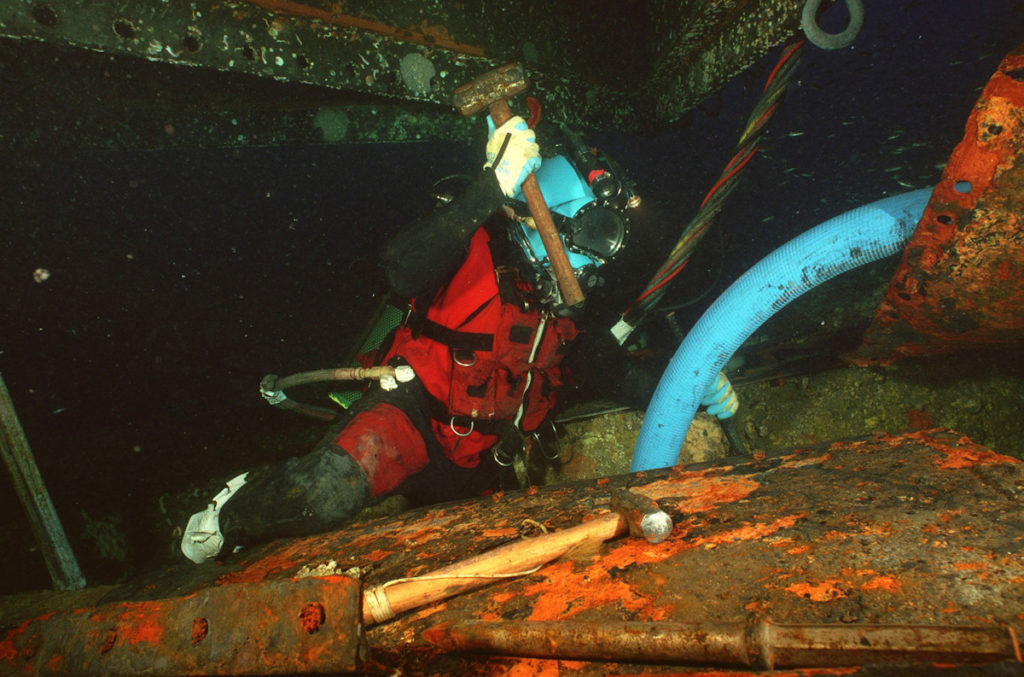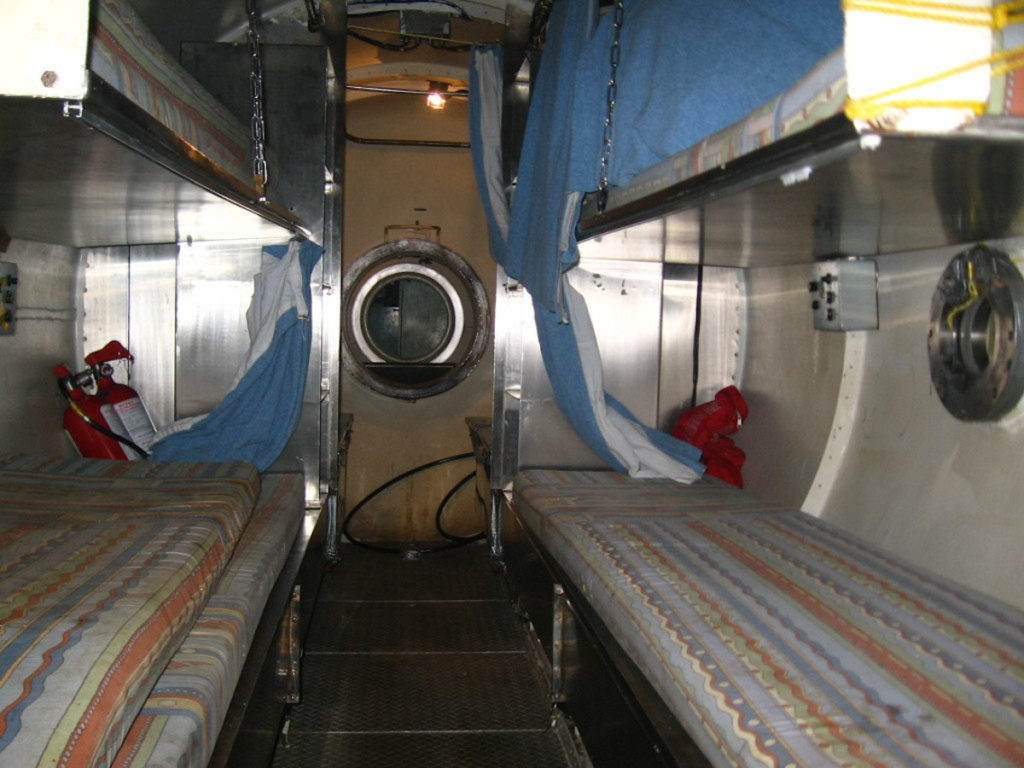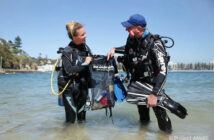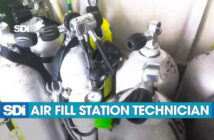“My deepest was 621 feet” “When you drop out into the unknown – and you know, I could be the first person that’s actually stood here. You’re in a different world. I love saturation diving. I’m home now for two months and I can’t wait to get back offshore right now. “
John Anderson
Saturation diving is when you dive for long enough to bring all of your tissues into balance with the partial pressures of the breathing gas’s inert components. It’s a diving technique that lets divers working at extreme depths to spend less time decompressing overall. A diver breathing pressurized gas accumulates dissolved inert gas used in the mixture to dilute oxygen to a non-toxic level in their tissues, which can cause decompression sickness (“the bends”) if allowed to come out of solution within the body tissues; thus, safely returning to the surface requires prolonged decompression so that the inert gases can be eliminated in the lungs. Decompression time does not increase with increased exposure after the dissolved gases in a diver’s tissues reach saturation point, because no more inert gas is accumulated. To avoid nitrogen narcosis, saturation divers normally breathe a helium–oxygen mixture, however at shallow depths, nitrox mixes have been used.
When not in the water, saturation divers live in a pressured environment that can be a saturation system on the surface or an ambient pressure underwater home. A closed, pressurized diving bell is used to transfer from the pressurized surface living quarters to the comparable depth underwater. This can last for several weeks, and they are only decompressed to atmospheric pressure once, at the end of their tour of duty. By reducing the number of decompressions, the danger of decompression sickness is greatly minimized, and the total amount of time spent decompressing is much reduced.
Only 336 of the 3,300 commercial divers employed in the United States in 2015 were saturation divers, indicating that it is a highly specialized sort of diving.

History of Saturation Diving
Edgar End and Max Nohl completed the first planned saturation dive on December 22, 1938, when they spent 27 hours breathing air at 101 feet sea water (fsw) (30.8 msw) in Milwaukee’s County Emergency Hospital recompression facility. After a five-hour decompression, Nohl developed a mild episode of decompression sickness, which was treated with recompression. In 1942, Albert R. Behnke presented the idea of exposing humans to elevated ambient pressures long enough for inert gases to become saturated in their blood and tissues. The Genesis experiment began in 1957 at the Naval Submarine Medical Research Laboratory, with the goal of establishing that people could endure prolonged exposure to various breathing gases and higher ambient pressures. The time it takes to decompress after reaching saturation is determined on the depth and gases breathed.
Trimix breathing gas was developed by Peter B. Bennett as a way to treat high blood pressure and nervousness. Bennett conducted an experiment called Atlantis III in 1981 at Duke University Medical Center, in which volunteers were subjected to a pressure of 2250 fsw (equivalent to a depth of 686 m in seawater) and slowly decompressed to atmospheric pressure over the course of 31 days, setting an early world record for depth-equivalent in the process. One of the participants in a later experiment, Atlantis IV, had euphoric hallucinations and hypomania, which caused issues.
Applications for Saturation Diving
Many deeper offshore areas employ saturation diving for bottom work because it allows the diver to make better use of his or her time while reducing the risk of decompression sickness. Surface oriented air diving is more common in shallower water. Underwater habitats are underwater structures in which people can live for extended periods of time and perform most of the basic human functions of a 24-hour day, such as working, resting, eating, grooming, and sleeping. The term ‘habitat’ is used in this context to refer to the structure’s interior and immediate exterior, as well as its fixtures, but not the surrounding aquatic environment. For oxygen, water, food, electricity, and other resources, most early underwater habitats lacked regenerative systems. However, rather than having to physically transport these resources, some new underwater habitats now allow them to be delivered via pipelines or manufactured within the habitat.
Since the early 1960s, private individuals and government entities have created, built, and utilized a variety of underwater habitats around the world. They’ve mostly been utilized for study and exploration, but at least one underwater habitat has been created for enjoyment and tourism in recent years. The physiological processes and restrictions of breathing gases under pressure, as well as aquanaut and astronaut training and studies on marine ecosystems, have all been the focus of research. Access to and from the exterior is usually made vertically through a moon pool in the structure’s bottom.

A decompression chamber may be included in the habitat, or individuals may be transferred to the surface through a closed diving bell.
Dangers of Saturation Diving
Saturation diving poses a high danger of both acute and chronic oxygen poisoning. The storage breathing gas exposes the divers to a constant level of oxygen concentration for long periods of time, on the order of a month at a time, requiring the gas in the habitat to be kept at a long-term tolerable partial pressure, typically around 0.4 bar, which is well tolerated and allows for large accidental deviations without hypoxia.
In saturation dives, there is some indication of a long-term cumulative loss in lung function.
Saturation divers are frequently plagued by skin rashes, otitis externa, and athlete’s foot, which develop during and after saturation dives. The increased partial pressure of oxygen, as well as the unusually high temperatures and humidity in the accommodation, are likely to be the cause.
Decompression injury, rather than living under saturation conditions, is thought to be the cause of dysbaric osteonecrosis.
Saturation diver training is usually done in commercial diving schools that are registered to train saturation divers and have the necessary infrastructure and equipment. A small number of organizations publish saturation diver training standards, and there is some international acknowledgment of equivalence. The diver must be qualified as a bell diver and have a certain number of dives and hours of experience since qualifying to begin training.
If you’re thinking about pursuing a career in saturation diving, think about the specifics of the profession before committing. While the income for saturation diving can be quite enticing to most potential candidates, the day-to-day living on the job can be extremely taxing.








